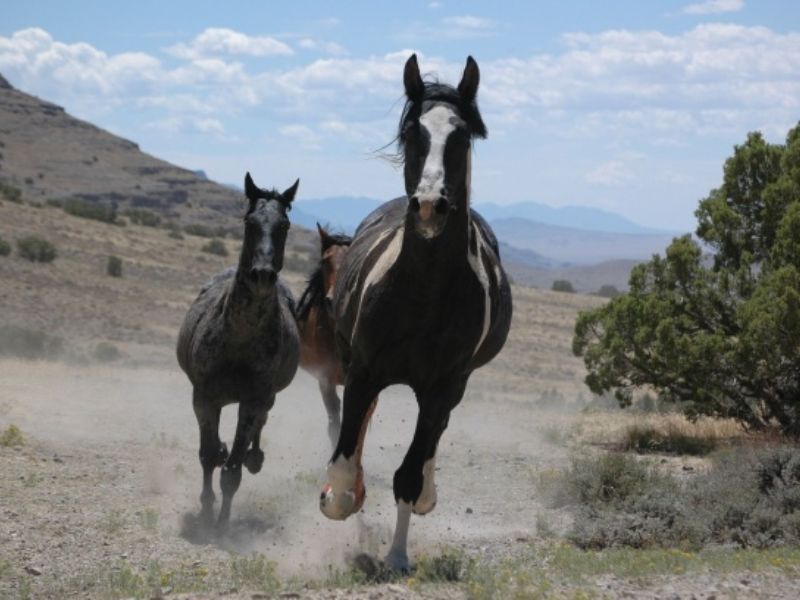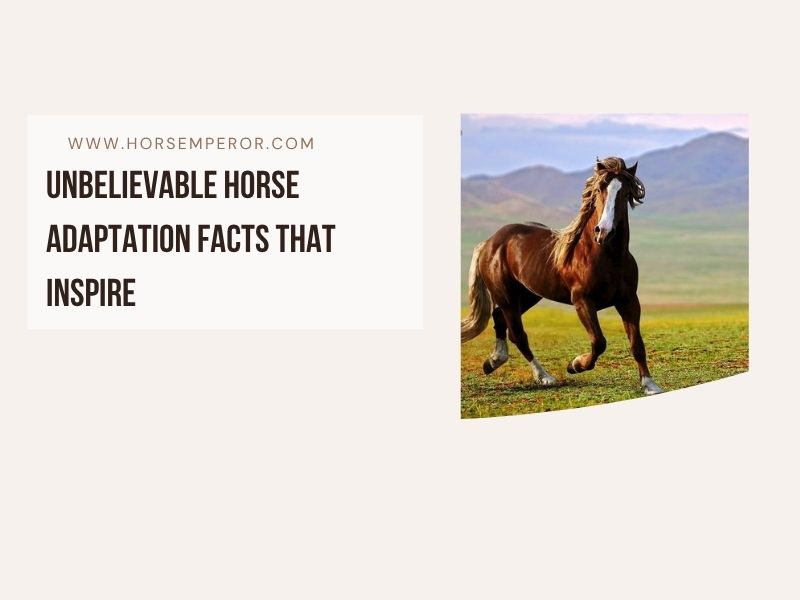It’s fascinating to see how horses have survived over 60 million years on this planet. They have evolved from a tiny ancestor, the Eohippus, to the strong Equus Caballus. It’s amazing to see how they have adapted to difficult conditions and environments where many animals have gone extinct.
When you review modern horses, you get to know the eye-opening facts about equine evolution. You learn about their survival strategy developed through years of adaptation to changing environments.
In this article, you will discover the 15 most interesting aspects of the evolutionary journey of these lovely horses. After reading, you’ll have a clear idea of how horses have changed over time.
- Evolutionary Journey
- Size Adaptation of Horses
- Color Adaptation of Horses
- Limbs and Hooves: Built for Speed and Distance
- Teeth and Jaws: Perfect for Grinding Grass
- Powerful Digestive System
- Almost 360-Degree Vision: Eyes That See Danger from Afar
- Swiveling Ears and Sharp Hearing
- Smell, Taste, and Touch
- Sleeping While Standing: The Stay Apparatus Magic
- Always on Guard: Fear Is Their Survival Skill
- Safety in Numbers: The Power of the Herd
- Smart and Sensitive: Horses Remember You
- Adapted by Breed: Climate Champions
- Surviving the Seasons: Weather Adaptations
- Super Senses: Skin and Touch Awareness
- Flexible Eaters: Diet That Adapts to Nature
- Why These Adaptations Matter Today
- References:
Evolutionary Journey
The evolution of horses started around 50–55 million years ago from a small, dog-sized animal known as Eohippus. With four toes on its front feet, this ancestor mostly ate soft leaves to survive, living safely in its sheltered forest environment.
But when the climate shifted and grasslands replaced forests, horses had to adapt quickly to survive. These evolutionary forces reshaped horses into creatures with longer limbs, fewer toes, and stronger teeth.
Size Adaptation of Horses
The ancestor of horses, Eohippus, was just 14–15 inches tall—about the size of a fox. Their short body size helped them survive in dense forests.
But when they moved to open grasslands, their body size became larger due to climate change. It was necessary for them to have a larger body for long-distance travel and predator avoidance.
Their body-changing journey started from the Eocene, Oligocene, Miocene, and Pliocene eras, evolving into the Kalobatippus, Parahippus, and Merychippus. During these eras, the ancestors of horses became taller, stronger, and more suited for open landscapes.
Now, the modern-day horse—Equus Caballus—stands at an impressive 70 inches tall, which is a result of horse adaptation through millions of years.
Color Adaptation of Horses
Color adaptation has also played a survival role in the horse’s journey. Wild horses used to have brown or gray coats that could easily blend with the forest floor, helping them avoid predators.
But when horses moved to grasslands, they developed dun coloration that could blend into dry vegetation and open terrain.
The wide color variations we see in domesticated horses today are due to selective breeding, not environmental needs. However, for wild horses, coat color still plays an important role in surviving in their natural habitat.

Limbs and Hooves: Built for Speed and Distance
The limb of horses is also very important to understand horse adaptations, because unlike most mammals, horses have no muscles in their knee or hock.
They mostly rely on tendons and ligaments to outrun predators, as it helps them get high energy and efficient movement.
The hoof of horses is a single hard structure made up of multiple toes. It supports them in traveling across diverse terrains such as soft plains, rocky ground, and uneven surfaces.
The keratin-rich hoof wall works as a natural shock absorber, helping reduce joint stress and providing stability.
Teeth and Jaws: Perfect for Grinding Grass
The diet of horses has also evolved according to environmental changes. As horses moved to open terrain, they started eating dry, fibrous grass filled with silica. It helped them develop high-crowned hypsodont teeth, which are resistant to wear.
Their ridged teeth, strong masseter muscles, and side-to-side jaw movement help them easily grind tough vegetation. This grinding motion also helps extract nutrients from low-protein plants and maintain digestive health.
Powerful Digestive System
It is fascinating to see the adaptation of the digestive system in horses. Since horses are herbivores, they rely on vegetation like grass and hay to stay strong and muscular. They get essential nutrients like protein from plants that are insoluble and indigestible for humans.
The enzymes in the human dietary tract can handle carbohydrates, but breaking down cellulose is impossible for humans. These plants contain cellulose, which is a carbohydrate found in plant cell walls. Cellulose gives structure and firmness to plants, so it also adds more fiber to a horse’s diet.
Evolutionary science has researched the equid family, including horses, rhinos, and tapirs. It shows that hindgut fermentation inside a horse’s colon helps digest cellulose, increasing nutrition in every bite of hay and grass.
Almost 360-Degree Vision: Eyes That See Danger from Afar
Horses’ visual system is a unique feature that has developed over a long history as prey animals. The eyes of horses are placed on the sides of heads, which gives them a wide field of view to see their surroundings and detect threats.
The peripheral vision and motion detection ability of horses help them spot movement and dangers like predators. The visual system and behavior of horses have largely evolved through evolutionary adaptations. Horses use monocular vision to look in different directions at the same time due to their limited binocular vision.
The night vision of horses—especially the rod cells in the retina—makes them sensitive to light in low-light conditions. The tapetum lucidum is a reflective layer that helps reflect the light back, allowing for better light absorption.
Their large eyes are one of the most notable features for their body size. Horses are also dichromats, which means their dichromatic vision helps them distinguish between blue and yellow, but not red and green.
Swiveling Ears and Sharp Hearing
The ears of horses also tell a unique story of their adaptation through their evolutionary journey. Each horse ear contains 10 muscles, which allow them to rotate 180 degrees independently.
This feature helps them detect sound, determine its direction, and get an idea about potential threats. These large, mobile ears have helped horses detect and escape predators in their grassland habitats.
Their swivel ears provide a full audio scan of their surroundings, which is a key survival trait in the wild.
Smell, Taste, and Touch
Horses have developed a strong sense of smell, which helps them identify predators, familiar horses, and the quality of forage. Their taste receptors help them avoid toxic plants and ensure a safe and nutritious diet.
The whiskers and sensitive skin of horses detect subtle touches. They also help horses navigate dark or crowded spaces.
These adaptations have helped horses communicate throughout their evolutionary journey and have played a crucial survival role in low-light settings.
Sleeping While Standing: The Stay Apparatus Magic
Horses have a cool ability called the stay apparatus. It’s a system of ligaments and tendons that lets them lock their legs so they can rest while standing up.
Since they’re prey animals, being able to nap on their feet helps them stay alert to danger and escape quickly if needed.
However, they still need to lie down for deep REM sleep, but that only takes up a small part of their daily rest. Most of the time, they rest while standing up and half-awake.
Always on Guard: Fear Is Their Survival Skill
Horses might seem jumpy, but that’s actually a survival instinct. Their natural reaction is to run first and think later. This fast response helps them escape predators in the wild.
Even tame, domestic horses still keep this instinctive fear. That’s why they sometimes spook at sudden movements or strange sounds—it’s just how they’re wired.

Safety in Numbers: The Power of the Herd
In the wild, horses live in herds. Being in a group helps them spot danger faster, protect each other, and feel safe and social.
This doesn’t change in modern times. Horses still need friends—whether it’s other horses, donkeys, or even goats. Being alone too much can make them stressed or depressed.
Smart and Sensitive: Horses Remember You
Studies show that horses have great emotional intelligence. They can:
- Recognize your face
- Respond to your voice
- Remember how you treated them—even years later
They also learn by watching others, spotting patterns, and through positive reinforcement. In short, they’re much smarter than most people think!
Adapted by Breed: Climate Champions
Different horse breeds are built for different weather:
- The Yakutian horse lives in freezing Siberia, where it survives −70°C winters with its thick fur and chunky body. It even digs through snow to find food.
- The Arabian horse, on the other hand, is made for the hot desert. It has wide nostrils to breathe easier, a slim body, and endless stamina for long desert trips.
Surviving the Seasons: Weather Adaptations
Horses are really good at adjusting to seasonal changes:
- In winter, they grow a thicker coat, fluff up their hair to trap heat (called piloerection), and burn more energy to stay warm.
- In summer, they sweat, roll in dust, and look for shade to stay cool.
Their bodies know just what to do when the seasons shift.
Super Senses: Skin and Touch Awareness
Horses have very sensitive skin. Their whiskers and nerve endings can feel the lightest touch—even a tiny fly!
This helps them:
- Sense bugs
- Move safely in the dark
- Respond gently to your touch while grooming or training
That’s why kind, careful handling is important—it respects their natural sensitivity.
Flexible Eaters: Diet That Adapts to Nature
Horses are great at finding food in nature. They mostly eat grasses, but they’re also smart about what they eat. Their sense of smell and taste help them pick out safe, healthy plants and avoid harmful ones.
This ability helps them survive in places where food is limited or seasonal.
Why These Adaptations Matter Today
Knowing about the evolutionary adaptations of horses helps in providing better care to them. Because by understanding their history, you can learn about their likes, dislikes, and health issues.
Understanding their constant need for forage, social interaction, and fear-based instincts can help in planning their feeding, shelter, and training.The biological traits teach us that horses are not just riding animals but survivors, shaped by millions of years of natural selection.
References:
- Live Science – Horse Leg Evolution
- Britannica – Digestive System of the Horse
- Kentucky Equine Research – Equine Senses
- NTU– Equine Cognition Studies
